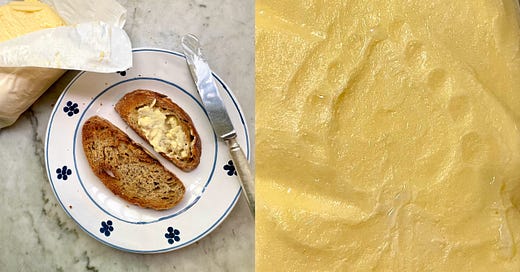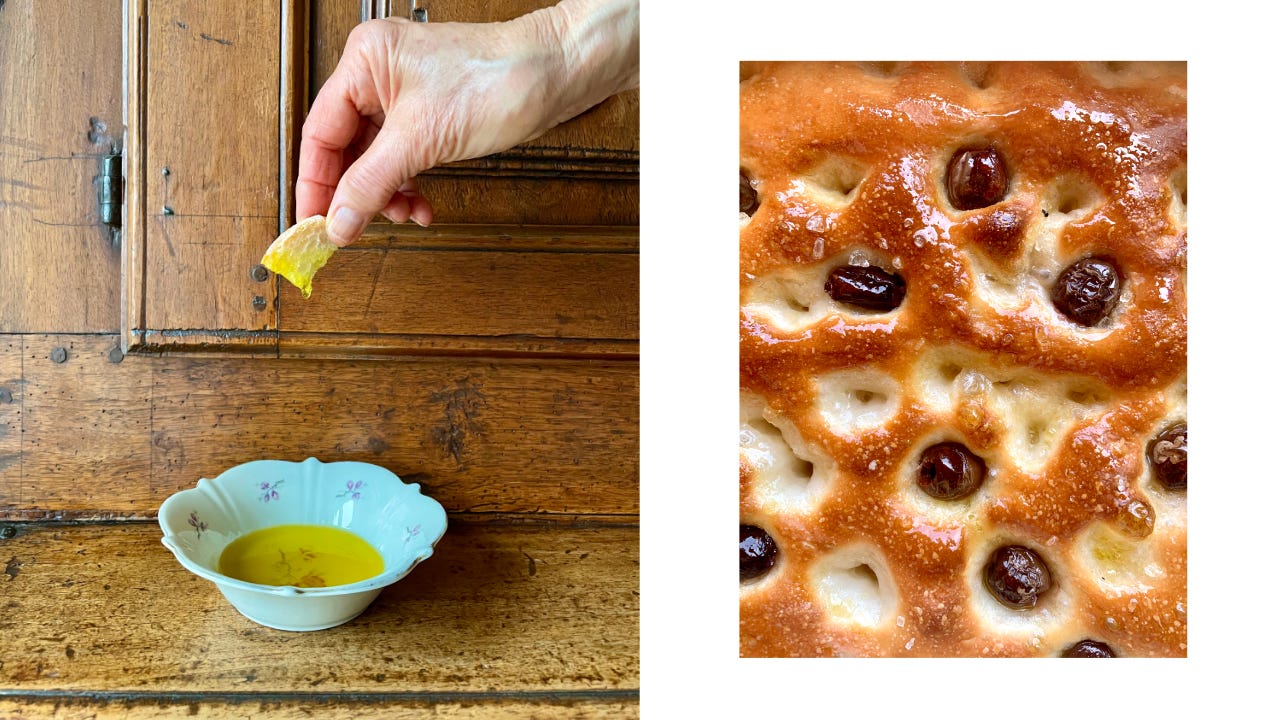By Carlotta Panza. Originally published on The New Gastronome in January 2022.

Two fats are the elementary components of Italian cuisine: I dare you to find a traditional recipe that doesn’t include one or the other. They have completely opposite organoleptic features and functions, yet are used for very similar purposes, from the beginning of a recipe, as soffritto, to the end of a recipe, as a raw condiment. Wherever they are used, they have the power of transforming any dish into a delicious feast by amplifying textures and flavours. For centuries, historical and geographical factors kept them separate- except in a few cases.
I’m talking about butter and olive oil, and the imaginary line that their usage traces across Italy. A line which divides the country into two parts: one which uses butter and the other which uses olive oil.
Olive oil
Olive oil is Italy’s liquid gold, one of the most important commodities that the country exports and a product capable of expressing itself extraordinarily differently from village, to province, to region. It is the singular ingredient at the basis of the Mediterranean diet, used as a raw condiment in parts of the country, to fry vegetables and meat in other areas and to preserve fresh produce everywhere.
Olive trees have existed on our earth for the last half million years, thriving on copious amounts of sun and surviving even in the most arid regions. Unlike wine, cheese and bread, whose production can be traced back for many centuries, olive oil requires the least effort and time, since it does not need to ferment nor cook: a large stone to grind the olives and a container in which to store the oil are sufficient.
The Etruscans are credited with diffusing the use of oil, as a luxury good, to the richest members of society throughout the Italian peninsula. Finally, during the rule of Ancient Rome, olive oil became a staple ingredient in the kitchen, used to add flavour and fatty components to dishes such as polenta, vegetables and cereals.
A few centuries later a divide was starting to form. Arab-Muslim reigns in the south and Christian reigns in the north divided the country in half, a split fuelled by their polar opposite religious beliefs and food practices. Only one element united them: a deep-rooted culture of olive oil. Their usage of oil was however radically different, tied to the two civilization’s conflicting cuisines, one preferring fried foods and the other healthier recipes with raw ingredients. It was a period that defined the contrasting use of olive oil usage between the North and South, passed down through generations and customs that is still evident today.
Olive oil consumption proliferated in southern Italian regions and in central hilly regions such as Umbria, Lazio and Tuscany, where olive tree cultivation thrives. On the other hand, just one region in the north of Italy has a traditional cuisine based around olive oil instead of butter: Liguria. Liguria is both coastal and hilly, providing the perfect environment for the tree’s growth.
In the other northern regions olive oil is scarcely present in traditional recipes - with the exception of Piemonte - where it is simply used as a condiment to season the final dish, a crudo, rather than an integral part of the dish.
Piemonte’s proximity to Liguria makes it the only region in Italy which has a substantial use of both olive oil and butter in its traditional cuisine. Although the regional cuisine used nut oils such as olio di noce for centuries, olive oil now plays a vital role in Piemonte’s sauces: making bagna caoda without immersing the anchovies in olive oil until they melt, simply wouldn’t be the same, nor would the bright green bagnet verd, used to accompany delicate lingua and bollito misto dishes. Liguria’s traditional recipes make use of olive oil in a very similar manner, further highlighting its influence on Piemonte’s gastronomy.
Lard
There is a third fat which is a vital component of traditional Italian cuisine of the past, not mentioned within the line traced by olive oil and butter due to its loss of relevance. Up until olive oil became the main fat used to cook with, lard was considered the staple ingredient of traditional cuisine. In modern-day Italy there are only two regions that still use lard as the starting point for most traditional dishes: Emilia-Romagna and Le Marche, whose cuisines are heavily reliant upon soft breads which are fried or cooked over a fire, such as gnocco fritto, piadine or crescione.
Lard was easily available, making its use widespread. Pigs, whose meat is excellent when aged and preserved with salt, had become domesticated animals around 8500 BC, meaning that families could feed off of one animal for a long time. Lard was one of the most precious parts: rich as butter, greasy as olive oil but without needing processing, nor cool temperatures to be stored.
Industrialisation lowered the price of olive oil, which increased its usage and allowed chefs and home cooks to include it in their dishes instead of lard. Part of the liquid gold’s success is due to the gastronomic traditions linked to religion, which shaped the development of national cuisine throughout Italy. In Italy, the consumption of meat was forbidden during Lent, so people only ate fish or vegetables. To prepare these foods, people began using olive oil since it was the only fat not sourced from meat. The use of olive oil became more widespread until it was a staple ingredient, preferred over lard because it was lighter and healthier.
Butter
Butter, capable of turning dough into the flakiest and most delicious melt-in-your-mouth croissant, became popular as a culinary ingredient at the end of the Middle Ages. Prior to its widespread usage in the kitchen, butter was used in Northern European communities, especially in the North of England and Scotland, to light lamps or to protect wooden ships’ hulls from sea water. Similarly to olive oil, it was used as a cosmetic product for centuries, some communities even using it to bathe, whereas Ancient Romans used it to style hair and other historical populations to cure eye and skin diseases. The division between populations’ usage of butter was driven by the Ancient Romans, who were in constant conflict with northern populations they regarded as barbarics and shunned everything the populations consumed - including butter.
Until industrial machines able to reproduce the centrifugal force necessary to churn butter were created, butter was reserved for the elite - especially the northern Italian one, since the 15°C temperature required for producing butter, and the cool storage temperatures, were more readily available in the northern regions. The invention of refrigerators, in the 20th Century, made butter more accessible to the rest of Italy, shifting from a luxury good to a normal good.
Although the whole of Italy has had easy access to fresh butter and high quality olive oil for decades, the division in usage is still evident. Thus, the different usages are not linked to accessibility but tradition, which is a concept with a very strong hold in Italy.
Pellegrino Artusi is credited with being the first person to include recipes from every Italian regional cuisine in one book, La Scienza in Cucina e L’arte di Mangiare Bene, published in 1891, hence - intentionally or not - he defined the staple dishes of each region. Flicking through Anna Gosetti della Salda’s 1967 book Le Ricette Regionali Italiane, one notices how traditional recipes have barely changed since Artusi’s book and how olive oil continues to be absent from recipes from Lombardia, Valle d’Aosta, Emilia Romagna, Friuli-Venezia Giulia, Trentino Alto Adige and Veneto.
Ancient populations, religion, geography, climate and gastronomers have all contributed in tracing the invisible line that divides in Italy in half. First, the barrier was set by climatic conditions and geographical locations, then by religious beliefs, political allegiances and social hierarchies. All these factors shaped what eventually were labelled as regional traditional cuisines, which have barely changed in the past 150 years.







Fascinating!
I blame The NY Times publishing of Marcella Hazan’s tomato sauce recipe and the incredible creamy texture in the sauce for pasta Sinatra—undoubtedly an American manifestation— for beginning my inclusion of butter into an otherwise completely Sicilian and Neapolitan family heritage. Suddenly my white clam sauce includes butter… I know, I know, blaspheme. In creating variations on a theme, scampi has transitioned to a garlic/butter/olive oil/lemon/white wine mix. I am sure both the northern and southern Italians would be lost in Hail Mary’s watching me do it.
I also know that during my time in Venice for the Biennale, no Italian turned down any of my cooking. I’m going to hold strong with my new butter convictions.
Now, let’s talk about that anchovy I snuck into the tomato sauce…
But damn. It’s good.
Lard is still used also in Sicily for most of desserts, both for frying and as an ingredient in the dough (ie cannoli, biscuits etc…).
This type of lardo as far as I know is the fat from under the skin of the back of the pig and it’s not cured. The lardo eaten as a salume is cured with salt and herbs but they are quite different.